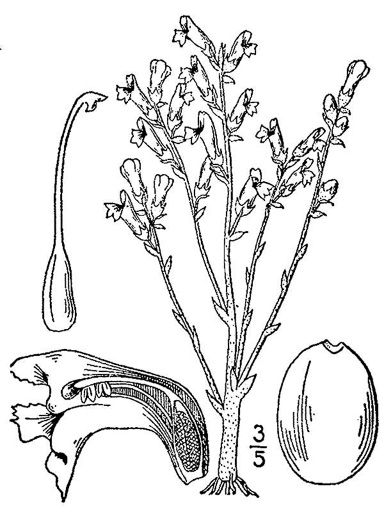Spermatophytes (seed plants): Angiosperms (flowering plants): Eudicots: Core Eudicots: Asterids: Lamiids: Lamiales
WEAKLEY'S FLORA OF THE SOUTHEASTERN US (4/24/22):
Phelipanche ramosa
FAMILY
Orobanchaceae
Go to FSUS key
Dig deeper at SERNEC, a consortium of southeastern herbaria.
Read about Bean Stranglers from Lytton Musselman and the Southern Appalachian Botanical Society.
Check out EDDMapS.org to see where this has been reported.
The flowers are lavender to violet, not yellowish as in O. minor. Read more about Branched Broomrape at Vascular Plants of North Carolina.
An infestation of this serious weed was discovered in 2007 at a car wash in urban Norfolk, VA, per Weakley's Flora (2022)
SYNONYMOUS WITH
PLANTS NATIONAL DATABASE:
Orobanche ramosa
FAMILY
Orobanchaceae
SYNONYMOUS WITH Floristic Synthesis of North America. BONAP (Kartesz, 2021)
Phelipanche ramosa
SYNONYMOUS WITH Flora of North America north of Mexico, vol. 17 (2019)
Orobanche ramosa
SYNONYMOUS WITH Britton & Brown Illus Flora of Northeast US & adjacent Canada (Gleason, 1952)
Orobanche ramosa
COMMON NAME:
Branching Broomrape, Hemp Broomrape, Branched Broomrape
To see larger pictures, click or hover over the thumbnails.
WEAKLEY'S FLORA OF THE SOUTHEASTERN US (4/24/22):
Phelipanche ramosa
FAMILY
Orobanchaceae
SYNONYMOUS WITH
PLANTS NATIONAL DATABASE:
Orobanche ramosa
FAMILY
Orobanchaceae
SYNONYMOUS WITH
Floristic Synthesis of North America. BONAP (Kartesz, 2021)
Phelipanche ramosa
SYNONYMOUS WITH
Flora of North America north of Mexico, vol. 17
Orobanche ramosa
SYNONYMOUS WITH
Britton & Brown Illus Flora of Northeast US & adjacent Canada (Gleason, 1952)
Orobanche ramosa
If a search such as "Carex leptalea var. leptalea" doesn't deliver the results you want, try "Carex leptalea".
Or, to minimize chances of a misspelling, try just "Carex le".
Less is more: If "pencil flower" doesn't deliver the results you want, try "pencil".


